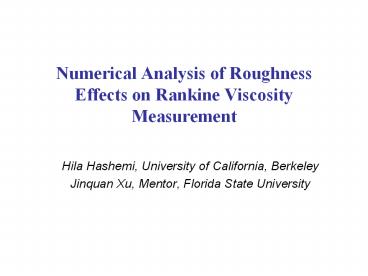Numerical Analysis of Roughness Effects on Rankine Viscosity Measurement - PowerPoint PPT Presentation
Title:
Numerical Analysis of Roughness Effects on Rankine Viscosity Measurement
Description:
Hila Hashemi, University of California, Berkeley. Jinquan Xu, Mentor, Florida State University ... Bird RB, Stewart WE, and Lightfoot EN, Transfer Phenomena, ... – PowerPoint PPT presentation
Number of Views:66
Avg rating:3.0/5.0
Title: Numerical Analysis of Roughness Effects on Rankine Viscosity Measurement
1
Numerical Analysis of Roughness Effects on
Rankine Viscosity Measurement
- Hila Hashemi, University of California, Berkeley
- Jinquan Xu, Mentor, Florida State University
2
Objective
- Collecting research experience on
computational science and applied mathematics,
including defining a problem, formulating
solution strategies, implementing the strategies,
and anglicizing the results
3
Overview
- Roughness effects on the pressure loss of
micro-scale Rankine Viscometer tubes are
numerically investigated - Surface roughness is explicitly modeled through a
set of generated peaks along an ideal smooth
surface - A parametric study is carried out to study the
relationship between the roughness and pressure
loss quantitatively.
4
Introduction
- Rankine Viscometer
- Hagen-Poiseuille law Newtonian fluid through a
cylindrical tube with an ideal SMOOTH surface
and
where
5
Introduction (cont.)
- Rough tube, with roughness ranging from 0.05.0
(Roughness defined as the ratio between the
average of the peak heights and the hydraulic
diameter.
Fig. 2 Cross-section of a rough micro tube.
(Picture courtesy Microgroup, Inc.)
6
Problem Formulation
- Numerical simulation of Newtonian fluid through
a cylindrical tube with a rough surface - Study of the relationship between tube length
and pressure loss - Generic modeling of flow in a short tube.
7
Problem Formulation (cont.)
- Boundary Conditions
- Inlet a specified velocity
- Outlet zero normal gradient
- Rough walls non-slip BC.
- Governing Equations
8
Solution Technique
Gambit is used for meshing The flow equations
are solved using the semi-implicit method for
pressure-linked equation algorithm implemented in
Fluent
9
Numerical Results And Discussions
- The relation between tube length and pressure loss
1. The pressure drop is linearly dependant to
the relative length of tube which is normalized
by a factor of 0.01658 meter 2. We can study a
short tube instead of a long one for expeditious
computation.
Smooth tube, Liquid O2, Re 15, r 165 µm
Fig. 4 The relation between the tube length and
pressure drop
10
Numerical Results And Discussions (cont.)
- Influence of roughness on pressure drop
and velocity
Liquid O2, r 165.8 µm, Re 15
Fig. 5 The pressure contour of different
roughness tube
11
Numerical Results And Discussions (cont.)
Liquid O2, r 165.8 µm, Re 15
Fig. 6 The influence of roughness on pressure drop
12
Numerical Results And Discussions (cont.)
Liquid O2, r 165.8 µm, Re 15
Fig. 7 The velocity vector of different roughness
tube
13
Numerical Results And Discussions (cont.)
5 roughness Liquid O2, r 165.8 µm
Fig. 8 The influence of flow velocity on pressure
drop
14
Conclusions
- The pressure loss is a linear function of the
tube length - The roughness affects on the pressure loss in a
non-trivial way The rougher a tube is, the more
the fluid pressure drops through the tube - It is feasibility to correct the Rankine
viscometer measured data through numerical
analysis - Mesh refinements are needed along the rough
boundary.
15
Reference
- Patankar SV, Numerical Heat Transfer and Fluid
Flow, Hemisphere Publishing Corporation, 1980. - Judy J, Maynes D, Webb BW, Characterization of
Frictional Pressure Drop for Liquid Flows through
Microchannels, International Journal of Heat and
Mass Transfer, Vol. 45, pp. 3477-89, 2002. - Bird RB, Stewart WE, and Lightfoot EN, Transfer
Phenomena, 2nd edition. John Wiley and Sons,
Inc., 2002. - Croce C and DAgaro P, Numerical Analysis of
Roughness Effect on Microtube Heat Transfer,
Superlattices and Microstructures. 2004. (In
press)































